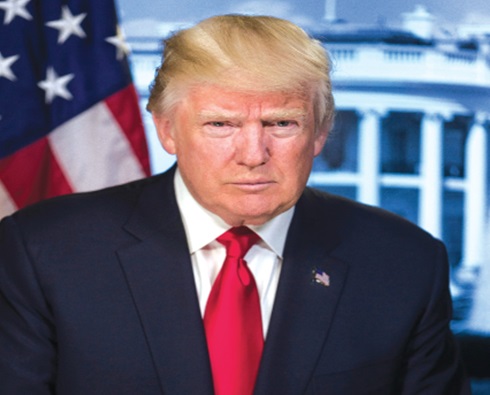The United States' decision to impose tariffs on all imports marks a pivotal moment in global trade dynamics.
While policymakers in Washington may argue that this move protects domestic industries and reduces dependency on foreign goods, the long-term consequences could be far-reaching.
This policy, rather than strengthening U.S. dominance, could signal the beginning of a declining phase in American hegemony in the global economic order.
At the same time, this shift presents an unprecedented opportunity for the African Continental Free Trade Area (AfCFTA) to emerge as a formidable player in global commerce.
Declining phase
For decades, the U.S. has led the global economy by promoting free trade and building strategic alliances.
However, its move to impose tariffs on all imports signals a shift toward protectionism, an approach that has historically led to retaliation, less efficient trade and strained diplomatic ties.
A key historical example is the Smoot-Hawley Tariff Act of 1930, enacted by President Herbert Hoover, in response to the Great Depression, to protect American industries and jobs by making foreign goods more expensive.
The immediate effect of the tariff was retaliation by major U.S. trading partners.
Countries such as Canada, Europe and Japan responded by imposing counter-tariffs on American exports.
This led to a sharp decline in global trade, and by 1933, U.S. exports had fallen by nearly 61 per cent.
The retaliatory measures created a vicious cycle where each nation sought to protect its own industries, ultimately stifling international commerce and cooperation.
As the US begins to walk the same path as did in the past, here’s how the current imposed tariffs could accelerate America's decline as the dominant global economic force:
● Erosion of free trade leadership
The U.S. has long been a champion of free-market capitalism, advocating for global trade liberalisation through agreements such as World Trade Organisation regulations and bilateral trade deals.
A blanket 10 per cent tariff contradicts these very principles, making it harder for the U.S. to argue against protectionist policies in other nations.
Countries that once followed America’s trade model may now look toward alternative economic leadership, particularly from China and the European Union.
● Strengthening of economic rivals
While the U.S. is imposing import taxes, China is expanding its trade footprint through the Belt and Road Initiative (BRI), strengthening ties with Africa, Asia and Latin America.
The EU is deepening its economic alliances through expanded trade agreements.
Meanwhile, BRICS nations (Brazil, Russia, India, China and South Africa) are actively promoting de-dollarisation and alternative financial systems.
By isolating itself with protectionist policies, the U.S. risks pushing its trade partners toward rival economic blocs, weakening its global influence.
● Declining trust dollar
One of the pillars of U.S. economic hegemony is the dominance of the U.S. dollar (USD) as the world’s reserve currency.
This dominance is maintained through global trade reliance on the USD for transactions and foreign exchange reserves.
However, if countries begin diversifying their trade away from the U.S. due to these tariffs, they may seek alternative settlement mechanisms in Chinese yuan, euros or regional currencies, further reducing reliance on the USD and diminishing American financial power.
Opportunity
As the U.S. retreats into protectionism, Africa has a unique opportunity to strengthen its economic integration through the AfCFTA. The AfCFTA is the largest free trade area by the number of participating countries, aiming to boost intra-African trade, industrialisation and economic self-sufficiency. Here’s how the U.S. tariff shift could accelerate Africa’s economic rise:
● Increased trade diversification
With reduced U.S. trade appeal, African nations will be incentivised to trade more with one another, strengthening regional supply chains and reducing reliance on external partners.
For example, Ghana, which exports cocoa to the U.S., can shift towards processing more cocoa locally and selling finished chocolate products within Africa, capturing greater value.
• Attraction of foreign investment
As the U.S. creates barriers to global commerce, investors seeking new markets with lower trade restrictions may turn to Africa.
The AfCFTA provides a 1.4-billion-person market with zero intra-African tariffs, making it an attractive destination for manufacturing, tech and agriculture-based industries.
For instance, automotive giants like Volkswagen and Toyota are already expanding operations in Ghana, Rwanda and South Africa to serve the African market rather than relying on Western exports.
• Strengthening Africa’s industrial base
Africa has historically been an exporter of raw materials rather than finished goods. However, with reduced Western trade dominance, African countries have the chance to scale up local production.
Nations like Nigeria, Egypt and South Africa are investing in textiles, pharmaceuticals and automotive industries, allowing them to become suppliers of finished goods to their neighbours instead of depending on imports from the U.S. or Europe.
Turning point
This tariff shift is a strategic blessing in disguise for Africa. The AfCFTA can step up to fill the void, integrate Africa’s economies and position the continent as the next global trade hub.
By leveraging this moment, Africa can transform from a raw-materials exporter into a competitive economic powerhouse, rewriting its role in the world order.
As global power realigns, the question is no longer whether the U.S. will maintain its hegemony but whether Africa will seize this moment to emerge as the next global economic frontier.
The writer is a Financial Economist/Research & Policy Analyst.
E-mail: numosuorephraim@gmail.com

